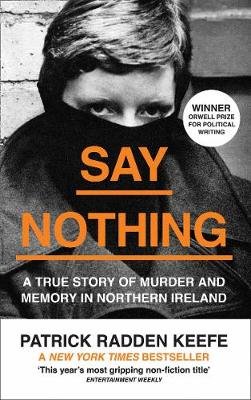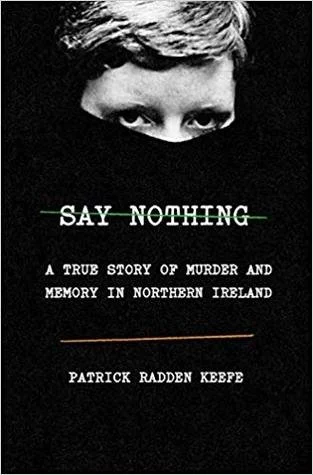Book Review - Say Nothing - Patrick Radden Keefe
As Patrick Radden Keefe says in the afterword of ‘Say nothing’, despite interviewing over a hundred people during the course of seven trips to Ireland over four years, there were many people who refused to speak to him, or started to, and thought better of it. Fifty years on, and there's still a lot of fear and anxiety out there; as they say in Belfast, 'History is alive, and dangerous.' And this book, after all, is called 'Say nothing.'
This isn't a history book, but a work of narrative non fiction. Patrick Radden Keefe chooses to focus on four individuals - Jean McConville, Brendan Hughes, Dolours Price and Gerry Adams. It's the abduction and murder of Jean McConville that Redden investigates forenscially that is very much the thread that runs throughout the whole book.
The Troubles
The initial section of ‘say nothing’ focuses on the attacks on the nationalist civil rights marches at the beginning of what is became know the troubles back in 1969, and the subsequent arrival of British troops. Radden Keefe does a good job of placing the troubles in a context, and how it lead to radicalisation among young nationalists who saw they had no way to protest against the power of the gerymandered state, set up to protect the Protestant population.
Three of those were Brendan Hughes, Gerry Adams and Dolours Price, who go on to join the IRA (or not in Gerry's case). Hughes is introduced during a white knuckle chase through the streets of Belfast, which is like something out of an action movie. The bombing campaign in London, which involves Price, is also incredibly compelling, and the section where she is force fed during a hunger strike is particularly visceral and shocking. So well detailed is her life recalled, that it's astounding to thing that Patrick Radden Keefe never spoke to her, or Hughes for that matter. The author also includes a fascinating discussion of the use of Hunger Strikes, one of many educational diversions throughout if you are unfamiliar with Irish history.
The story of Jean McConville is shocking, and the treatment of the ten abandoned children is equally heartbreaking. It's the usual Irish story of being abused by the system set up to protect them, though Redden doesn’t go into this in detail. He has a tight hold of the narrative and the story he wants to tell in ‘Say nothing.’. The act of 'disappearing people' is chilling and author does a good job of bringing across how cold and calculating an act that it was.
Magnetic Characters
Hughes and Price are magnetic characters, wedded to the idea of revolution, but who eventually become jaded and bitter, left behind by the peace process steered by Adams. The author makes the point that In the end it feels that Adams was the one who picked the right course. Adams does comes across as quite slippery, but he's vey media savvy and strategic. He didn't talk to Radden Keefe and has always denied he was in the IRA, and disputes the accounts on the Boston tapes, which became a political football in a chain of events that is scarcely believable in the last few sections in the book.
There are so many individuals in ‘Say nothing’. Frank Kitson, the British intelligence officer in the North, using all of the dirty tricks he learned from Britains colonial exploits in Kenya and Cyprus. Father Alec Reid, tending to two dying British army officers, and when he gets home he realises that an envelope passed to him that details the IRA's fledgling moves towards peace, is marked by blood from his hands. It's details like this, the personal stories, that make this book such essential reading. It's a tribute to Radden keefe’s talent as a storyteller that he is able to bring these characters and events back to life again - it flows like a fictional page turner.
Whilst I was listening to ‘say nothing’ during one of my daily walks, I found myself outside the exact place in the book when the narrator referred to Dolores Price being moved from prison in England - to Armagh jail. It gave me a chill and I looked up at the windows, wondering if the Price sisters had ever gazed through them, and could Dolores see St Patricks Cathedral, where she would later marry the actor, Stephen Rea. I suppose it's inevitable when you're living in the north that you will come across some of the places mentioned in the book.
Violence
There are some incidents here that play out in the background that I recall from my youth. John Craven's newsround talking about Michael Stones attack on Mairead Farrells funeral. RTE radio’s GAA round up being interrupted as I made my way back across Cavan and Monaghan with my father and uncle after an Armagh match, to bring us news of the Enniskillen bombing. A John wayne film being interrupted to bring the news of another massacre, but I can’t remember which one. And I distinctly remember discussing the death of Bobby Sands the day after he died with the kids in my estate, sitting on the kerb after being told not to wander too far.
A word appreciation for the narrator of the audiobook here - really good to hear a local accent narrating events, using just the right emotional tone - can't have been easy over nearly fifteen hours. I have heard the criticism that the narrative doesn't focus on Loyalist violence but I think that's a different book. This is not a history of the troubles.
Say Nothing Summary
One of the best compliments I can pay ‘say nothing’ is that I stretched my walk out a bit longer just to get to the end of a chapter. I knew a lot of the stories but it's the way Patrick Radden Keefe structures the book along with the parallel lives of the main characters that makes it all the more compelling. I think it also helped that he is American, allowing him to straddle the divide and get access to people, as he has no skin in the game. He has his own ideas on who fired the gun that killed Jean McConville, which I won’t disclose here. I have a shelf of books on Irish politics and history and this is up there with any of them. It would be an especially good read for anyone who has wondered about the conflict in the north and isn't sure where to begin. It’'s not definitive, and not meant to be, but a fascinating book to get you started.
Book review - Say nothing - A true story of murder and memory in Northern Ireland by Patrick Radden Keefe
519 Pages
Published by Doubleday
14 hours 43 minutes narrated by Matt Blaney
Amazon US Amazon UK
Other books I’ve reviewed by this author - Rogues - true stories of grifters, killers, rebels and crooks and ‘Empire of Pain’
Update Nov 23: It seems that Disney are planning to make a ten part drama series based on the book. Filming has already taken place in England. It has been said that the family of Jean McConville have said they are ‘Upset and disgusted’ that their mothers death is being used for entertainment purposes.
Update November 24: Apparently the Disney ‘Say Nothing’ series is about to air this week. I’ve been purposely avoiding reviews, and will approach with an open mind. Maxine Peake is an actor I always enjoy watching, so interested to see how she plays Dolours Price.
As always, read the book first.



